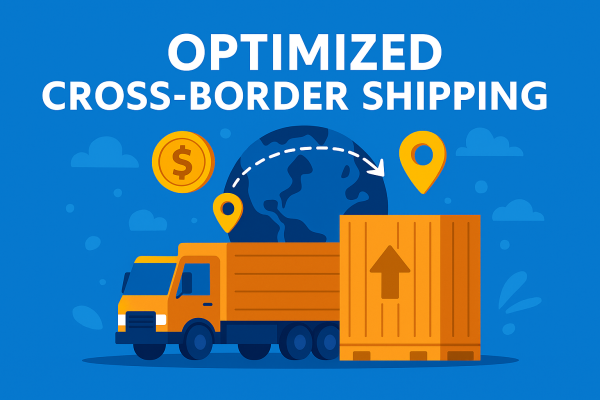Smart company founders and scale-up leaders rarely talk about pallets and ports, but they should. Shipping choices define customer experience, cash flow and carbon footprint long before marketing or sales shine. Modern cross-border logistics has transformed from a necessary cost into a strategic asset, giving ambitious businesses a way to outperform larger competitors focused solely on price.
Cross-border strategies to outperform competitors
Cross-border demand continues to grow. Astute Analytica expects the global market to increase from $2.83 trillion in 2023 to $16.45 trillion by 2032, with a compound annual growth rate of 21.6%. However, growth alone won’t help challengers succeed. These seven tactics will.
1. Follow the volume, then redirect it
Purolator Senior Vice President Paul Tessy recalls a German shoe brand whose containers entered Vancouver, detoured 2,000 kilometers to Ontario for sorting and then doubled back to western shores. Transit times fell and costs plunged by simply splitting the load in-province and injecting it directly into its network. The lesson is to map actual demand centers, not legacy hubs, and then reroute at the first touch point. Distributed induction beats megahubs for speed and fuel burn, especially when the carrier owns nationwide assets.
2. Plan for tariff uncertainty, not stability
North American shippers spent $2.3 trillion on logistics in 2024 – 8.7% of U.S. GDP. Every unexpected duty hike affects that number. Scenario modeling, free trade zones and duty-drawback programs convert volatility into savings. Providers that analyze tariff scenarios with clients can redeploy stock or shift Incoterms within hours, maintaining landed cost and customer promises.
3. Automate the middle mile
Mordor Intelligence expects the automated warehouse market to grow at an 11.07% CAGR between 2025 and 2030. Companies like Amazon have implemented robotic picking and automated storage and retrieval systems (ASRS) to manage high product volumes with minimal human intervention. Automation isn’t just for large companies. Affordable AMRs, dimensioners and AI-driven sortation allow midmarket exporters to run efficient cross-docks near borders and shift staff to higher-value work like exception management.
4. Consolidate duties with smart customs optimization
Purolator’s customs team shows that duty-free eligibility under USMCA, in-bond moves and low-value shipment rules can eliminate or defer entire fee classes when trade professionals review HS codes and paperwork upfront. Small to medium enterprises can improve thin margins without sacrificing delivery speed.
5. Digitize border paperwork and use AI for verification
World Customs Organization surveys in 2024 highlight new AI-based compliance tools that flag anomalies before inspection queues form – reducing release times and fines. Combined with e-manifest APIs and blockchain-backed bills of lading, businesses can reduce multiday holds to hours, crucial for shipping perishables or flash-sale items.
6. Build visibility for better service
Real-time IoT sensors and cloud control towers give customer-facing teams precise ETAs to promise “Tuesday before noon” instead of “sometime next week.” Research shows end-to-end visibility cuts shipment losses by up to 50% and speeds disruption response by 40%. Better SLAs lead to higher cart conversion and fewer WISMO (“where is my order”) tickets.
7. Combine efficient and flexible networks for sustainable growth
Companies using regional distribution hubs, predictive analytics and flexible contracts improve customer service levels by 20% to 30% while reducing inventory by 15% to 20%. Efficient networks reduce waste while flexible ones handle unexpected changes, ensuring you maintain both cost control and responsiveness when international sales increase.
Sustainability: The new shipping priority
A 2024 PwC global survey found that consumers will pay 9.7% more for goods that travel through verifiably sustainable supply chains, transforming logistics from cost center to brand asset.
Purolator’s 2024 report cites a 14% cut in Scope 1-2 emissions from 2020 and 150 new electric delivery trucks, while expanding same-day coverage. Similar initiatives like right-sized packaging and AI route optimization reduce fuel use and parcel costs together. Shippers that share these metrics on product pages and RFPs convert carbon savings into higher sales and customer loyalty, showing that sustainable shipping drives profitable growth.
When freight drives business success
Cross-border leaders succeed not by spending more but by designing, digitizing and improving faster than established companies can update old contracts. From rerouted sneaker shipments to AI-detected tariff issues, optimized shipping transforms logistics into a driver of revenue, sustainability and customer trust.
Logistics isn’t just back-office operations, it’s business strategy. Start small: review HS codes, test a regional induction point, try a visibility dashboard, then expand what works. As cross-border e-commerce grows, companies that treat shipping as an opportunity for innovation rather than an afterthought will control the routes and win the customers that matter most.






